AUDI R8 SPYDER 2014 Owners Manual
Manufacturer: AUDI, Model Year: 2014, Model line: R8 SPYDER, Model: AUDI R8 SPYDER 2014Pages: 244, PDF Size: 61.06 MB
Page 131 of 244

The airbag system is monitored electronically
to make certain that it is functioning properly
at all times. Each time you turn on the igniĀ
tion, the airbag system indicator light will
come on for a few seconds (self diagnostics) .
The side airbag system supp lements the safeĀ
ty belts and can help to reduce the risk of inĀ
jury to the driver's and front passenger's upĀ
per torso and head injuries on the side of the
ve hicle that is st ruck in a side co llision . The
airbag deploys in s ide impacts and only when
the veh icle acce lerat ion registered by the conĀ
trol un it is high enough. If this rate is below
the refe rence va lue p rogrammed into the conĀ
trol un it, the s ide a irbags w ill not be trigĀ
gered, even though the car may be bad ly dam Ā
aged as a result of the collision . It is not pos Ā
sib le to define an airbag tr igger ing range that
will cover every poss ible angle of impact,
since the c ircumstances will vary considerab ly
between one collision and anothe r. Important
factors include, fo r example, the nature (hard
or soft) of the impacting object, the angle of i mpa ct, veh icle speed, e tc.Ā¢
page 130, ImĀ
portant safety instru ctions on the side airbag
system .
Aside from the ir normal safety function, safeĀ
ty belts wor k to he lp keep t he d river or front
passenger in posi tion in the event of a side
coll is ion so that the side a irbags can provide
p rotection.
The airbag sys tem is
not a subs titute for your
safety be lt. R athe r, it is pa rt of the overall ocĀ
cupant res traint system in your veh icle . AlĀ
ways remember that the side airbag system
can only he lp to protect you if you are wearing
your safety belt and wear ing it properly. Th is
is another reason w hy you sho uld always wear
your safety belts, not just because the law reĀ
qu ires you to do soĀ¢
page 103, General
notes.
It is important to remember that while the
supp lemental s ide a irbag system is designed
to reduce the like lihood of serious injur ies,
other i njuries, for example, swell ing, b ruising,
and minor abras ions can also be assoc iated
with deployed s ide a irbags . Remem ber too,
A irbag system 129
side airbags wi ll dep loy only once and only in
certain kinds of accidents -your safety belts
are always the re to offer p rotection.
Vehicle damage, repair costs or even t he lack
of ve hicle damage are not necessarily an indi Ā
cation of over-sensitive or failed airbag activaĀ
tion . In some coll is ions, both front and side
airbags may inflate. Remember too, that airĀ bags will deploy only once a nd only in certain
k inds of col lisions -your safety be lts a re alĀ
ways the re to offe r protection in those acc iĀ
dents in which airbags are not supposed to
deploy or when they have a lready deployed .
The side airbag system will not deploy:
-when the ignit io n is turned off
- in side co llisions when the acceleration
meas ured by the sensor is too low
- in rear-end co llisions
- in rollove rs .
In some types of ac cidents the front airbags
and s ide a ir b ag s may be triggere d toge ther.
A_ WARNING
- Safety belts and the airbag system wi ll
only provide protection when occupants
are in the proper seating position
Ā¢page 130.
-If the ai rbag indicator light comes on
when the vehicle is being used, have the
system inspected immediately by your
author ized Audi dealer. The airbag may
not work properly when the vehicle acĀ
c e leration in a side collis ion is high
e nough to activate t he a irbag. ā¢
ā¢
Page 132 of 244
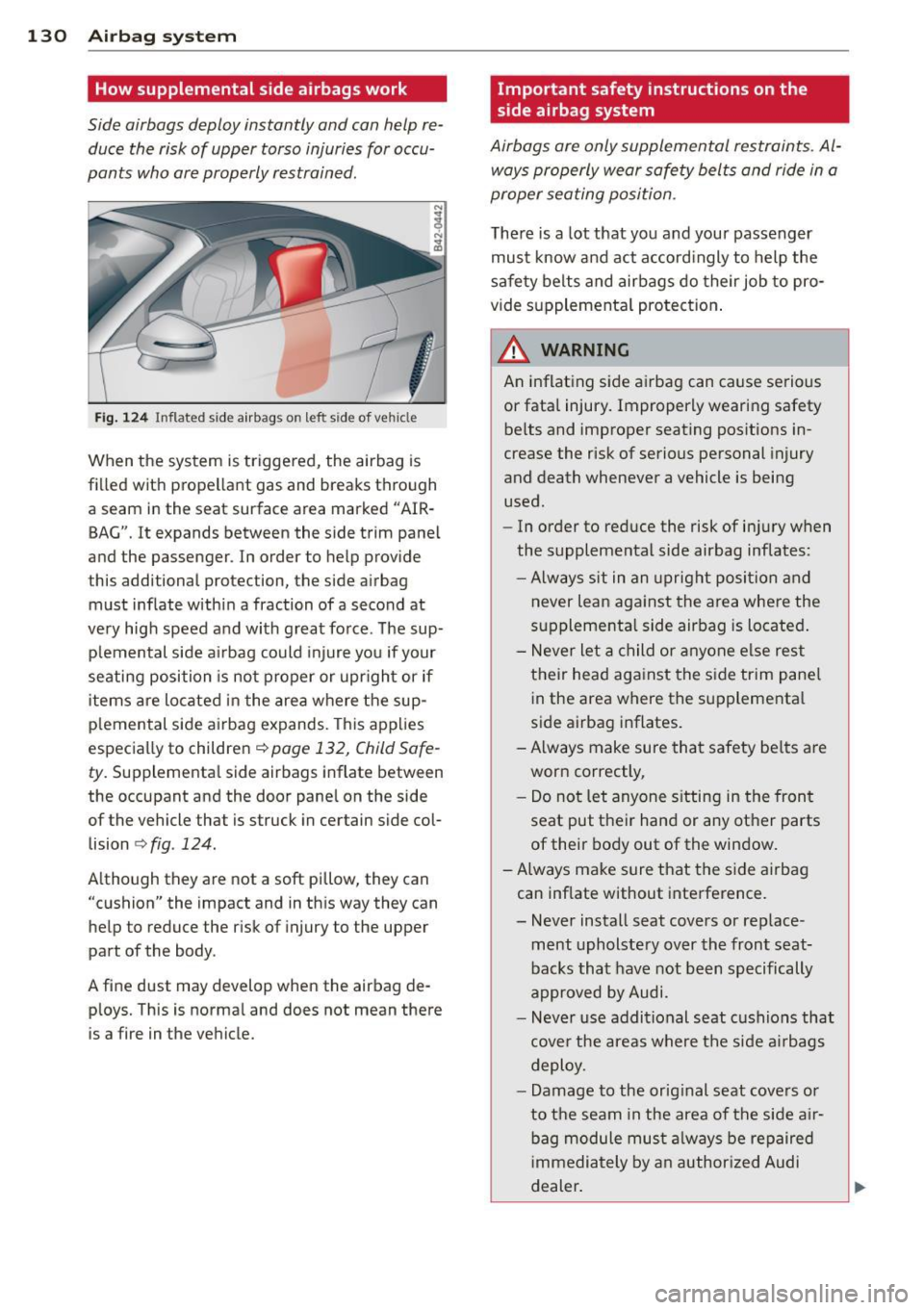
130 Airbag system
How supplemental side airbags work
Side airbags deploy instantly and con help reĀ
duce the risk of upper torso injuries for occuĀ
pants who ore properly restrained.
Fi g. 1 24 Inflated s ide airbags on left side of vehicle
When the system is triggered, the airbag is
filled with prope llant gas and breaks through
a seam in the seat surface area marked "AIRĀ
BAG". It expands between the side trim pane l
and the passenger . In order to help provide
this additional protection, the side airbag
must inflate within a fraction of a second at
very hig h speed and with great force. The supĀ
plemental side airbag could i njure you if your
seating position is no t proper or upr ight or if
items are located in the area where the supĀ
p lemental side airbag expands. This applies
especial ly to children
Q page 132, Child SafeĀ
ty.
Supplementa l side airbags inflate between
the occupant and the door pane l on the side
of the vehicle that is struck in certain side colĀ
lision
Q fig . 124.
A lthough they are not a soft pillow, they can
"cushion" the impact and in th is way they can
he lp to reduce the risk of injury to the upper
part of the body.
A fine dust may develop when the airbag deĀ
p loys. This is norma l and does not mean there
is a fire in the vehicle. Important safety instructions on the
side airbag system
Airbags ore only
supplemental restraints. AlĀ
ways properly wear safe ty belts and ride in a
proper seating position.
The re is a lot that you and your passenger
must know and act accord ingly to help the
safety belts and airbags do their job to proĀ
vide supplementa l protect ion .
A WARNING
An inflating side ai rbag can cause serious
or fata l injury. Improperly weari ng safety
belts and improper seating positions inĀ
crease the risk of serious personal injury
and death whenever a vehicle is being
used .
- In order to reduce the risk of inj ury when
the supplemental side airbag inflates:
- Always sit in an upright posi tion and
never lean aga inst the area whe re the
s u ppleme nta l side air bag is located .
- Never let a child or a nyone e lse rest
t h eir head aga inst the s ide trim pane l
in the area where the supplementa l
side airbag inflates.
-Always make sure tha t safety be lts a re
worn correctly,
- Do no t let anyone s itting in the fron t
seat put t heir hand or any ot her parts
of their body out of the win dow.
-Always make sure that the side airbag can inflate without interference.
- Neve r install seat covers or rep laceĀ
ment upholstery over th e front seatĀ
backs that have not been specifically
approved by Audi.
- Neve r use additional seat c ushions that
cove r the areas where the side a irbags
deploy.
- Damage to the orig inal seat cove rs or
to t he seam in the area of the si de a irĀ
bag module mus t always be repaired
i mmediately by a n author ized Audi
dealer.
Page 133 of 244

-Objects between you and the airbag can
increase the risk of injury in an accident
by interfering with the way the airbag
unfolds or by being pushed into you as
the airbag inflates .
- Never place or attach accessories or
other objects (such as cup holders, telĀ
ephone brackets, or even large, bulky
objects) on the doors, over or near the
area marked "AIRBAG" on the seat
backrests.
- Such objects and accessories can beĀ
come dangerous projectiles and cause
injury when the supplemental side airĀ
bag deploys .
- Never carry any objects or pets in the
deployment space between them and
the airbags or allow children or other
passengers to travel in this position.
-Always prevent the side airbags from beĀ ing damaged by heavy objects knocking
against or hitting the sides of the seatĀ
backs.
- The airbag system can only be triggered
once. If the airbag has been triggered,
the system must be replaced by an auĀ
thorized Audi dealership.
- Damage (cracks, deep scratches etc.) to
the original seat covers or to the seam in
the area of the side airbag module must always be repaired immediately by an auĀ
thorized Audi dealer.
- If children are seated improperly, their
risk of injury increases in the case of an
accident
c> page 132, Child Safety.
- Never attempt to modify any compoĀ
nents of the airbag system in any way.
- In a side collision, side airbags will not
function properly if sensors cannot corĀ
rectly measure increasing air pressure inĀ
side the doors when air escapes through
larger, unclosed openings in the door
panel.
- Never drive with interior door trim panĀ
els removed.
- Never drive when parts have been reĀ
moved from the inside door panel and
Airbag system 131
the openings they leave have not been
properly closed.
- Never drive when loudspeakers in the
doors have been removed unless the
speaker holes have been properly
closed.
- Always make certain that openings are
covered or filled if additional speakers
or other equipment is installed in the inside door panels.
- Always have work on the doors done by
an authorized Audi dealer or qualified
workshop.
ā¢
ā¢
Page 134 of 244
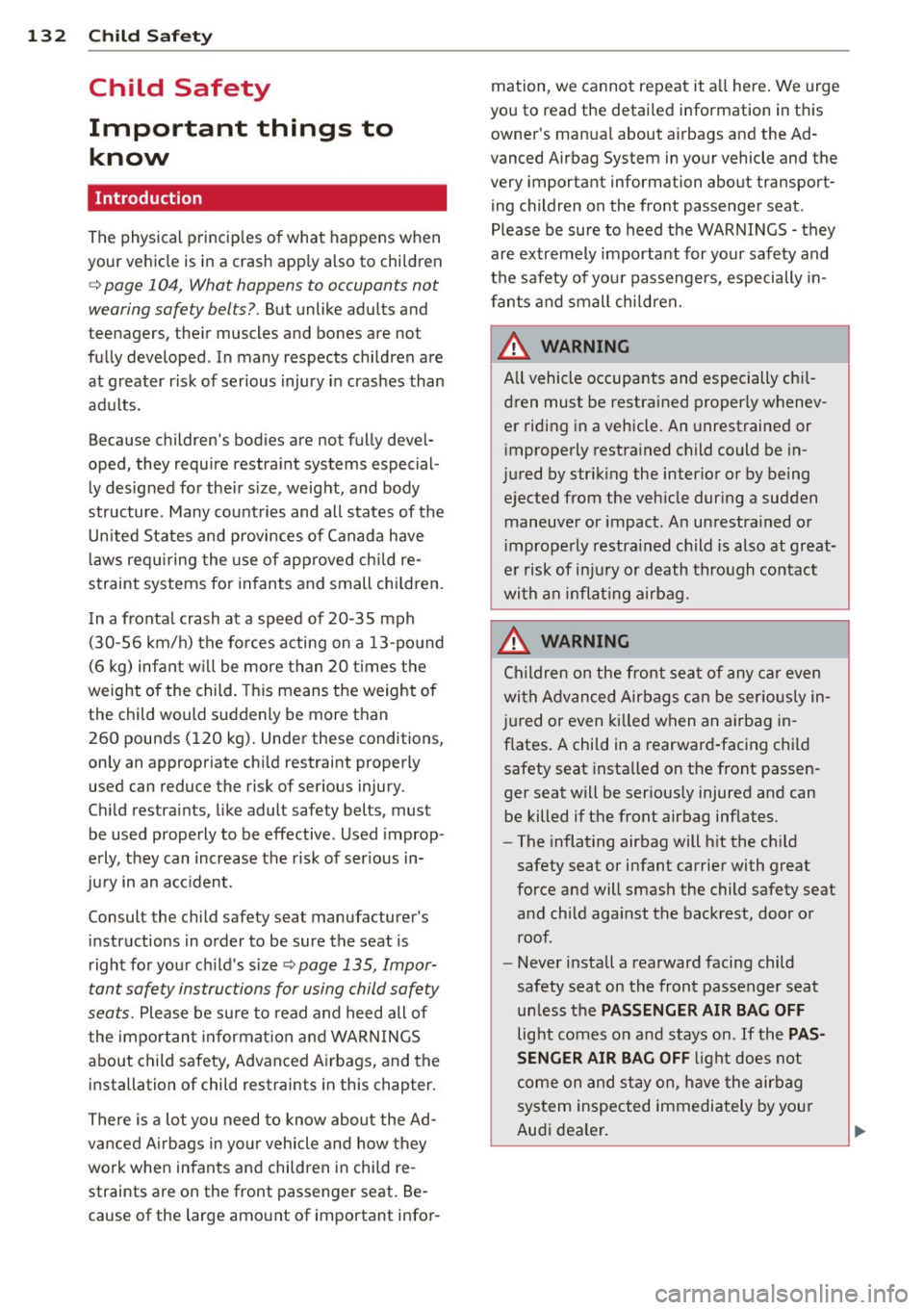
132 Child Safety
Child Safety
Important things to know
Introduction
The physical principles of what happens when
your vehicle is in a crash apply also to children
c::> page 104, What happens to occupants not
wearing safety belts? .
But unlike adults and
teenagers, their muscles and bones are not
fully developed . In many respects children are
at greater risk of serious injury in crashes than
adults.
Because children's bodies are not fully develĀ
oped, they require restraint systems especial Ā
ly designed for their size, weight, and body
structure . Many countries and all states of the
United States and provinces of Canada have
laws requiring the use of approved child reĀ
straint systems for infants and small children.
In a frontal crash at a speed of 20-35 mph
(30-56 km/h) the forces acting on a 13-pound
(6 kg) infant will be more than 20 times the
weight of the child. This means the weight of
the child would suddenly be more than 260 pounds (120 kg). Under these conditions,
only an appropriate child restraint properly used can reduce the risk of serious injury.
Child restraints, like adult safety belts, must
be used properly to be effective. Used impropĀ
erly, they can increase the risk of serious inĀ
jury in an accident.
Consult the child safety seat manufacturer's instructions in order to be sure the seat is
right for your child's size
c::> page 135, ImporĀ
tant safety instructions for using child safety
seats.
Please be sure to read and heed all of
the important information and WARNINGS
about child safety, Advanced Airbags, and the
installation of child restraints in this chapter.
There is a lot you need to know about the AdĀ
vanced Airbags in your vehicle and how they
work when infants and children in child reĀ
straints are on the front passenger seat. BeĀ
cause of the large amount of important infor- mation, we cannot repeat it all here. We urge
you to read the detailed information in this
owner's manual about airbags and the AdĀ
vanced Airbag System in your vehicle and the
very important information about transportĀ ing children on the front passenger seat.
Please be sure to heed the WARNINGS - they
are extremely important for your safety and
the safety of your passengers, especially inĀ
fants and small children.
A WARNING
-
All vehicle occupants and especially chilĀ
dren must be restrained properly whenevĀ
er riding in a vehicle. An unrestrained or
improperly restrained child could be inĀ
jured by striking the interior or by being
ejected from the vehicle during a sudden maneuver or impact. An unrestrained or
improperly restrained child is also at greatĀ
er risk of injury or death through contact
with an inflating airbag.
_& WARNING
Children on the front seat of any car even
with Advanced Airbags can be seriously inĀ
jured or even killed when an airbag inĀ
flates. A child in a rearward-facing child
safety seat installed on the front passenĀ
ger seat will be seriously injured and can
be killed if the front airbag inflates.
- The inflating airbag will hit the child
safety seat or infant carrier with great
force and will smash the child safety seat
and child against the backrest, door or roof.
- Never install a rearward facing child
safety seat on the front passenger seat
unless the
PASSENGER AIR BAG OFF
light comes on and stays on. If the PASĀ·
SENGER AIR BAG OFF
light does not
come on and stay on, have the airbag
system inspected immediately by your
Audi dealer.
.
Page 135 of 244

A WARNING
-=
If, in exceptional circumstances, you must
install a forward-facing child restraint on
the front passenger's seat:
- Always make sure the forward-facing
seat has been designed and certified by
its manufacturer for use on a front seat
with a passenger front and side airbag.
-Always follow the manufacturer's inĀ
structions provided with the child safety
seat or carrier.
- Always move the passenger seat into its
rearmost position in the seat's fore and
aft adjustment range, as far away from
the airbag as possible before installing
the child restraint. The backrest must be
adjusted to an upright position.
- Always make sure that the
PASSENGER
AIR BAG OFF light comes on and stays
on all the time whenever the ignition is
switched on.
(D Tips
Always replace child restraints that were
installed in a vehicle during a crash. DamĀ
age to a child restraint that is not visible
could cause it to fail in another collision
situation.
Advanced front airbag system and children
Your vehicle is equipped with an "Advanced
Airbag System" in compliance with United
States Federal Motor Vehicle Safety Standard
(FMVSS) 208 as applicable at the time your
vehicle was manufactured.
The Advanced Airbag system in your vehicle
has been certified to meet the "low-risk " reĀ
quirements for 3- and 6- year-old children on
the passenger side and small adults on the
driver side. The low risk deployment criteria
are intended to reduce the risk of injury
through interaction with the airbag that can
occur, for example, by being too close to the
steering wheel and instrument panel when
the airbag inflates. In addition, the system
Child Safety 133
has been certified to comply with the "supĀ
pression" requirements of the Safety StandĀ
ard, to turn off the front airbag for infants up
to 12 months who are restrained on the front passenger seat in child restraints that are listĀ
ed in the Standard .
Even though your vehicle is equipped with an
Advanced Airbag system, a child should alĀ
ways ride in the seat properly restrained for
its age and size . The airbag on the passenger
side makes the front seat a potentially danĀ
gerous place for a child to ride. The front seat
is not the safest place for a child in a forwardĀ
facing child safety seat .
It can be a very danĀ
gerous place for an infant or a larger child in a
rearward-facing seat.
Advanced Airbags and the weightĀ
sensing mat in the front seat
The Advanced Airbag System in your vehicle
detects the presence of an infant or child in a
child restraint on the front passenger seat usĀ
ing the weight-sensing mat in the seat cushĀ
ion and the sensor below the safety belt latch
on the front passenger seat that measures the
tension on the safety belt.
The weight-sensing mat measures total
weight of the child and the child safety seat
and a child blanket on the front passenger
seat. The weight on the front passenger seat
is related to the design of the child restraint
and its "footprint", the size and shape of the
bottom of the child restraint as it sits on the
seat. The weight of a child restraint and its
"footprint" vary for different kinds of child reĀ
straints and for the different models of the
same kind of child restraint offered by child restraint manufacturers.
The weight ranges for the individual types,
makes and models of child restraints that the
NHTSA has specified in the Safety Standard
together with the weight ranges of typical inĀ
fants and typical 1 year-old child have been
stored in the control unit of the Advanced AirĀ
bag System. When a child restraint is being
used on the front passenger seat with a
ll-
ā¢
ā¢
Page 136 of 244
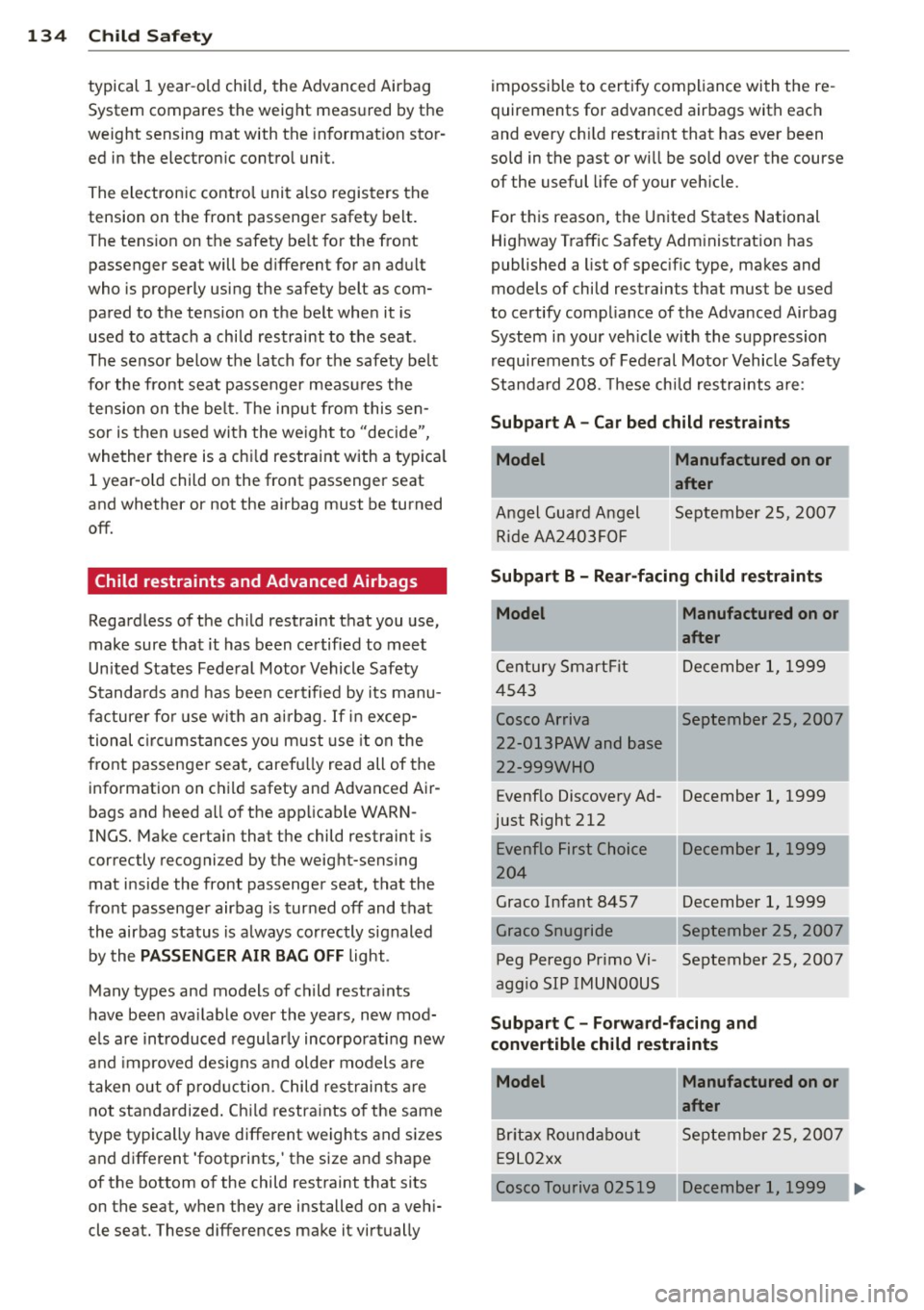
134 Child Saf ety
typical 1 year -old chi ld, the Advanced Airbag
System compares the weight meas ured by the
weight sensing mat with the in format ion storĀ
ed in the electron ic contro l unit.
The electron ic contro l unit a lso registers the
tension on the front passenge r safety belt.
The tens ion on the safety be lt fo r the front
passenger seat will be d ifferent for an adult
who is properly using the safety belt as comĀ
pared to the tension on t he be lt whe n it is
used to attach a child restraint to the seat.
The senso r below the latch fo r the safety be lt
fo r the front seat passenger measu res the
tension on the be lt. T he inp ut from this senĀ
sor is then used with the we igh t to "decide",
whether there is a chi ld restraint with a typica l
1 year-o ld child o n the front passenger seat
and whether or not the airbag must be turned
off.
Child restraints and Advanced Airbags
Regardless of the ch ild restraint that you use,
make sure tha t it has been ce rtified to meet
Un ited States Fede ral Motor Vehicle Safety
S tanda rds a nd has been cer tified by its manuĀ
facture r fo r u se wit h an air bag. If i n excepĀ
tional circumstances yo u m ust use it on the
front passenge r seat, caref ully read all of the
info rmation on c hild safety an d Advanced AirĀ
bags and heed a ll of the app licable WARNĀ
INGS. Make certai n that t he child restraint is
correctly recognized by the weig ht-sensing
mat i nside the front passenger seat, that the
fro nt passenge r airbag is tur ned off and that
the airbag status is a lways correctly signaled
by the
PASSENGER AIR BAG OFF light .
Many types and models of child restra ints
have been ava ilable over the years, new modĀ
e ls ar e introduced regularly incorporat ing new
a nd improved designs a nd older models are
taken out of p ro du ction. Child res traints are
not stan dardized . Ch ild restra ints o f the same
type typically have different weights and s izes
a nd d ifferent 'footprints,' the s ize and s hape
of the bottom o f the child restraint that sits
on the seat, when they are installed on a veh iĀ
cle seat. These differences make it virtually impossible to certify compliance wi
th t he re Ā
quirements for a dvanced airbags with eac h
and every ch ild restra int that has ever been
sold in the past or wi ll be sold over the course
of the useful life of your veh icle.
For t his reason, the United States National
Hig hway T raffic Safety Adm inistrat ion has
published a list of spec ific type, ma kes and
m odels of child restraints that must be used
to certify comp liance of the Advanced Airbag
System i n your veh icle w ith the su ppr ession
r equirem ents of Federal Motor Vehicle Safety
Standa rd 208. These chi ld restraints a re :
Subpart A -Car bed child restraints
Model
Angel Guard Angel
R ide AA 2403F OF Manufactured on or
after
September 25, 2007
Subpart B - Rear-facing child restraints
Model
Century Sm art Fi t
4 543
Cosco Arriva
22 -013PAW and base
22-999 WHO
Evenflo Discove ry AdĀ
just Right 212
E venflo First Choice
2 04
Graco Infant 8457
G raco Snug ride
Peg Perego Pr im o ViĀ
aggio SIP IMU NOOUS Manufactured on or
after
D ecembe r 1, 1999
Septemb er 25, 20 07
Decembe r 1, 1999
D ecember 1, 1 999
Decembe r 1, 1999
September 25, 2007
September 25, 2007
Subpart C -Forward-facing and
convertible child restraints '
.
'
.
Model Manufactured on or
Ā·
B rita x Round about
E 9 L0 2xx after
Sep
tember 25, 2007
Cosco Touriva 02519 Decemb er
1, 1999
'
Page 137 of 244
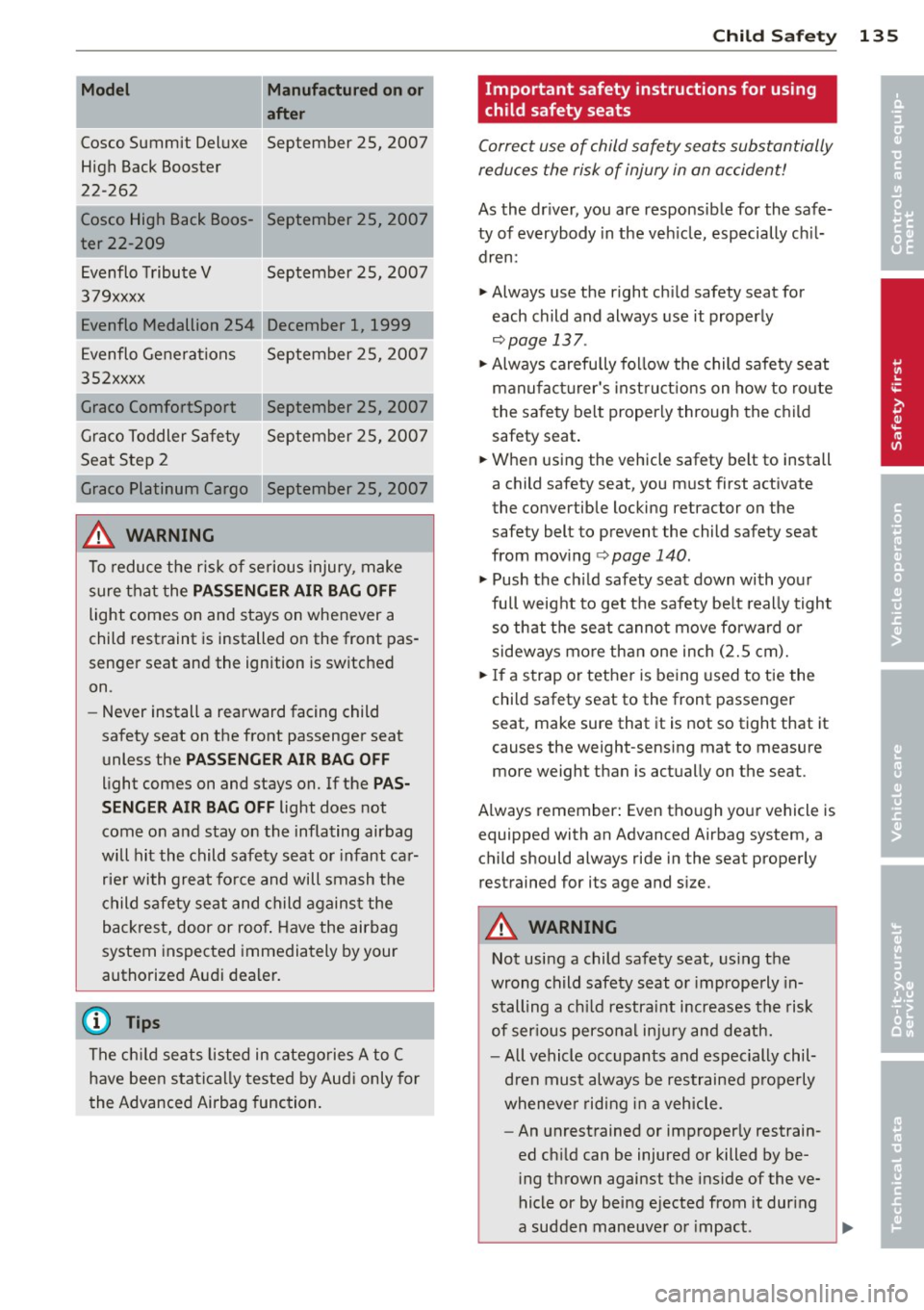
Model Manufactured on or
after
Cosco Summit Deluxe September 25, 2007
H igh Back Bo oste r
22-262
Co sco High Bac k Boos -September 2S, 2007
ter 22- 209
Evenfl o Tribut e V
379xxxx September 25, 2007
December 1, 1999
E
venflo Genera tions September 25, 2007
35 2xxxx
Grace ComfortSport September 2S, 2007
Grace Toddler Sa fety September 25, 200 7
Seat Step 2
Graco Platinum Cargo September 25, 2007
A WARNING
T o reduce the risk of serious injury, make
sure that the
PASSENGER AIR BAG OFF
light comes on and stays on whenever a
child rest raint is installed on the front pas Ā
senger seat and the ignition is switched
on.
- Never install a rearward facing child
safety seat on the front passenger seat
unless the
PASSENGER AIR BAG OFF
light comes on and stays on. If the PASĀ
SENGER AIR BAG OFF
light does not
come on a nd stay on the inflating airbag
will hit the child safety seat o r infant ca rĀ
rie r wi th great fo rce and will smash the
c hild s afety seat and child agains t the
backrest, door or roof . Have the airbag
system inspected immedia tely by your
authorized Audi dealer.
(D Tips
The ch ild seats listed in catego ries A to C
have been sta tica lly tested by Au di only for
the Advanced Airbag function.
.
Child Sa fet y 135
Important safety instructions for us ing
child safety seats
Correct use of child safety seats substantially
reduces the risk of injury in an accident!
As the dr iver, you are respons ible for the safeĀ
ty of everybody in the veh icle , especially ch ilĀ
dren:
.. Always use the right ch ild safety seat for
each child and always use it properly
r=;, page 137.
.. Always carefully fo llow the child safe ty seat
manufac turer's inst ruct io ns on how to ro ute
the sa fe ty be lt properly through the c hild
safety seat .
.. When using the vehicle safety belt to install
a child safety seat, you m ust first activate
the convertible locking retractor on the
safety belt to prevent the child safety seat
from mov ing
Ā¢ page 140 .
.. Push the ch ild safety seat down with yo ur
full weight to get the safety be lt really tight
so that the seat cannot
move fo rwa rd o r
sideways more th an one inch
(2.5 cm).
.. If a s trap or tet her is be ing used to tie the
child safety seat to the front passenger
seat, make sure that it is not so tight that it
causes the weight-sensing mat to measure
more weight than is act ually on the seat.
A lways remember : Even tho ugh yo ur vehicle is
equipped with an Advanced Airbag system, a
c hi ld should always ride in the seat properly
restrained for its age and s ize.
A WARNING
N ot using a child safety seat, using the
wrong ch ild safety seat o r imprope rly inĀ
stalling a ch ild restraint increases the risk
of ser ious persona l inju ry and death.
- All vehicle occupants and especially chilĀ
dren must always be restrained p rope rly
wheneve r riding in a vehicle.
-
- An unrest rained or improper ly restrainĀ
ed ch ild can be injured or killed by beĀ
i ng t hrown against the ins ide of the
veĀ
hicle or by being e jected from it dur ing
a sudden maneuve r o r i mpact .
ā¢
ā¢
Page 138 of 244
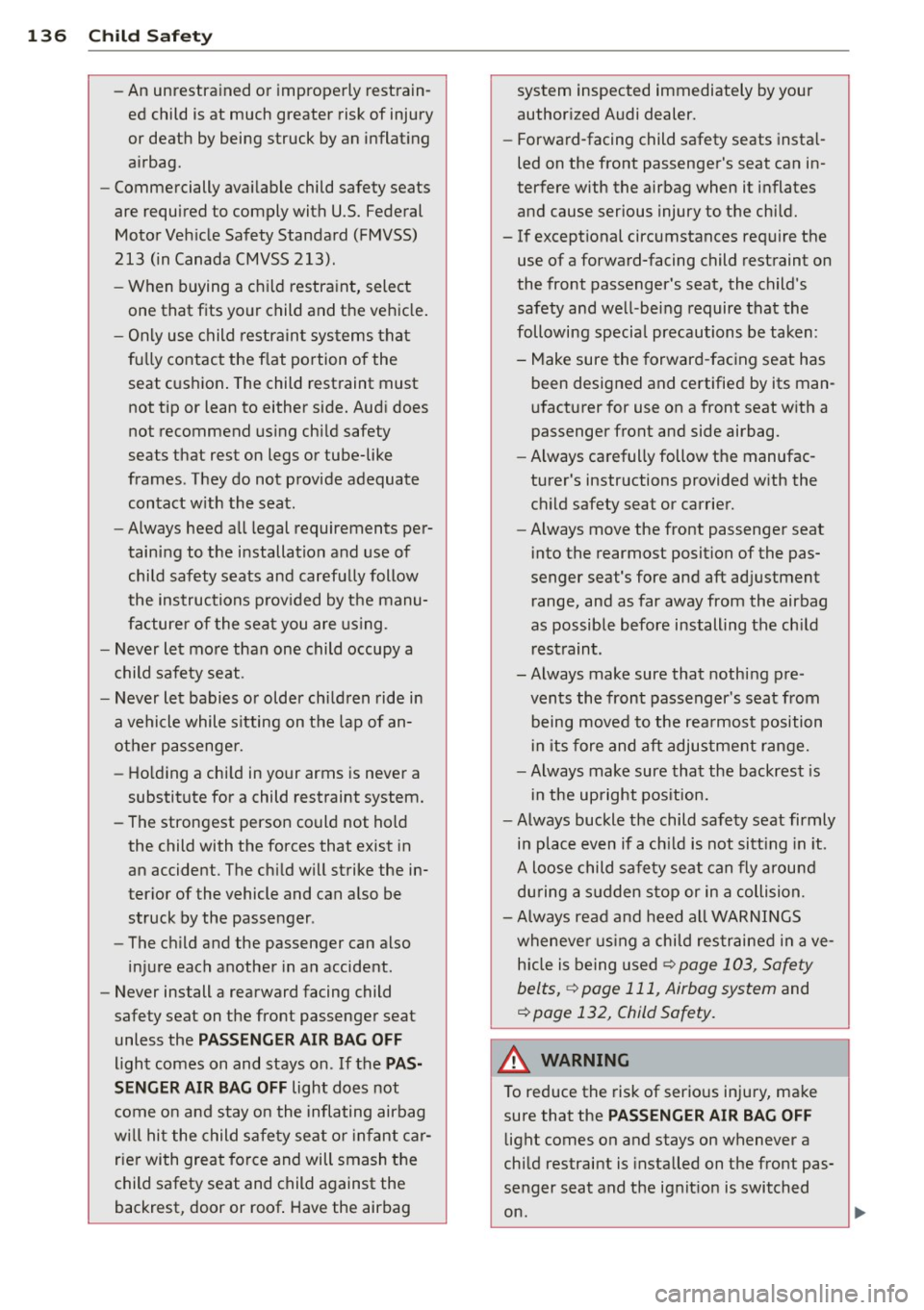
136 Child Safety
-An unrestrained or improperly restrainĀ
ed child is at much greater risk of injury
or death by being struck by an inflating
airbag .
- Commercially available child safety seats
are required to comply with U.S. Federal
Motor Vehicle Safety Standard (FMVSS)
213 (in Canada CMVSS 213).
- When buying a child restraint, select
one that fits your child and the vehicle.
- Only use child restraint systems that
fully contact the flat portion of the
seat cushion. The child restraint must
not tip or lean to either side. Audi does
not recommend using child safety
seats that rest on legs or tube-like
frames . They do not provide adequate
contact with the seat .
- Always heed all legal requirements perĀ
taining to the installation and use of
child safety seats and carefully follow
the instructions provided by the manuĀ
facturer of the seat you are using.
- Never let more than one child occupy a
child safety seat.
- Never let babies or older children ride in
a vehicle while sitting on the lap of anĀ
other passenger.
- Holding a child in your arms is never a
substitute for a child restraint system.
- The strongest person could not hold
the child with the forces that exist in
an accident. The child will strike the inĀ
terior of the vehicle and can also be
struck by the passenger .
- The child and the passenger can also
injure each another in an accident.
- Never install a rearward facing child
safety seat on the front passenger seat
unless the
PASSENGER AIR BAG OFF
light comes on and stays on. If the PASĀ
SENGER AIR BAG OFF
light does not
come on and stay on the inflating airbag
will hit the child safety seat or infant carĀ
rier with great force and will smash the
child safety seat and child against the
backrest, door or roof. Have the airbag system inspected immediately by your
authorized Audi dealer.
- Forward-facing child safety seats instalĀ
led on the front passenger's seat can inĀ
terfere with the airbag when it inflates
and cause serious injury to the child.
- If exceptional circumstances require the
use of a forward-facing child restraint on
the front passenger's seat, the child's
safety and well -being require that the
following special precautions be taken :
- Make sure the forward-facing seat has
been designed and certified by its manĀ
ufacturer for use on a front seat with a
passenger front and side airbag.
- Always carefully follow the manufacĀ
turer's instructions provided with the
child safety seat or carrier.
- Always move the front passenger seat
into the rearmost position of the pasĀ
senger seat 's fore and aft adjustment
range, and as far away from the airbag
as possible before installing the child
restraint.
- Always make sure that nothing pre Ā
vents the front passenger's seat from
being moved to the rearmost position
in its fore and aft adjustment range.
- Always make sure that the backrest is
in the upright position.
- Always buckle the child safety seat firmly
in place even if a child is not sitting in it.
A loose child safety seat can fly around
during a sudden stop or in a collision.
- Always read and heed all WARNINGS
whenever using a child restrained in aveĀ
hicle is being used
Ā¢ page 103, Safety
belts,
Ā¢ page 111, Airbag system and
~ page 132, Child Safety .
A WARNING ~
To reduce the risk of serious injury, make
sure that the
PASSENGER AIR BAG OFF
light comes on and stays on whenever a
child restraint is installed on the front pasĀ
senger seat and the ignition is switched
on.
Page 139 of 244
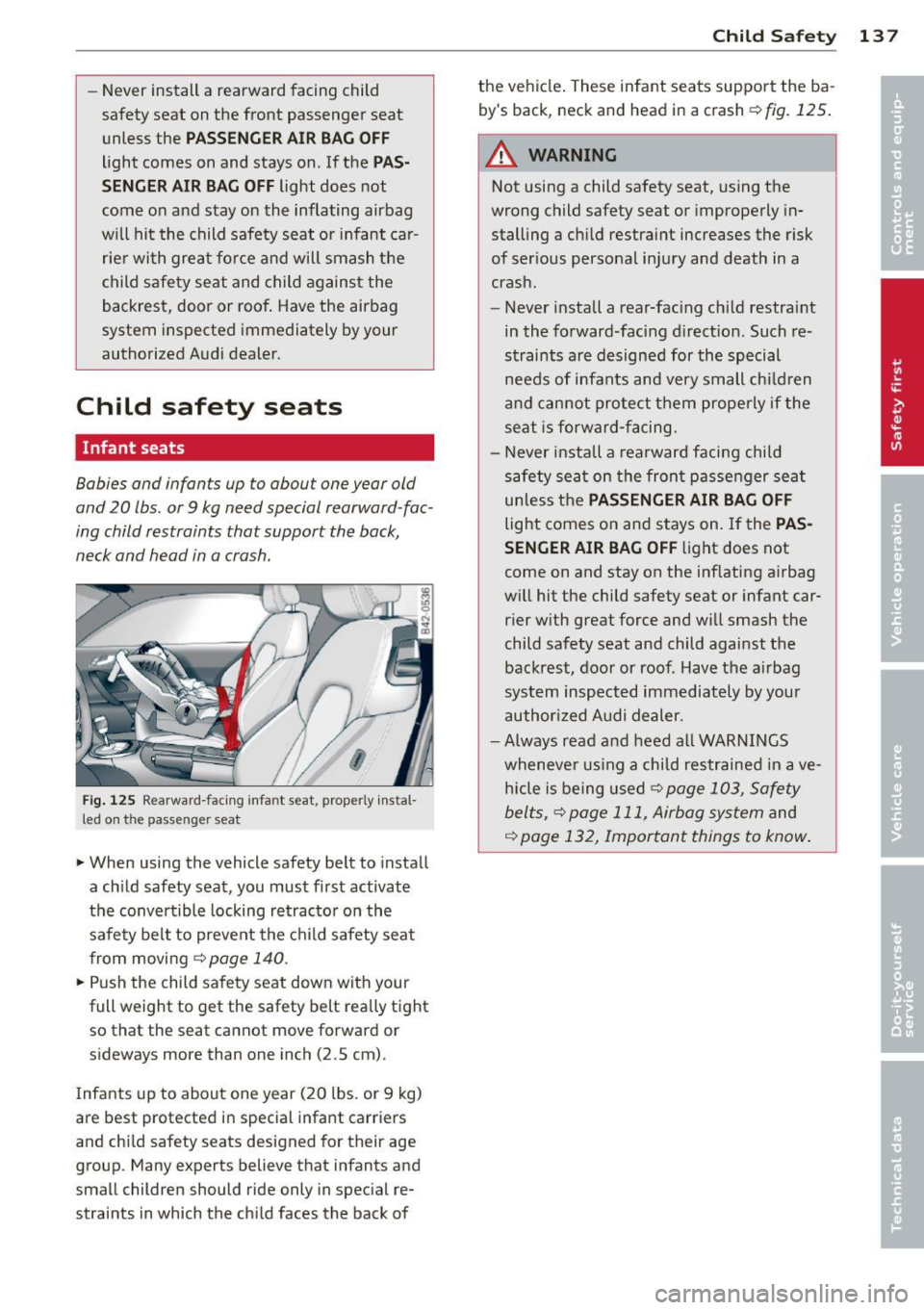
-Never install a rearward facing child
safety seat on the front passenger seat
unless the
PAS SENGER AIR BA G OFF
light comes on and stays on . If the PA SĀ
SEN GER AI R BAG OFF
light does not
come on and stay on the inflating airbag
will hit the child safety seat o r infant carĀ
r ie r with great fo rce and will smash the
child safety seat and child against the
backrest, door or roof . Have the airbag
system inspected immediately by your authorized Audi dealer .
Child safety seats
Infant seats
Babies and infants up to abou t one year old
and 20 lbs . or 9 kg need special rearward -fac Ā
ing child restraints that support the back,
neck and head in a crash.
Fig . 125 Re arwar d-fa cing infan t sea t, pr operly instal Ā
le d on t he p asseng er se at
"' When using the vehicle safety belt to in stall
a ch ild safety seat , you must first activate
the convertible locking retractor on the
safety belt to prevent the ch ild safety seat
from moving
r::!v page 140 .
"' Push the child sa fety seat dow n with your
full weight to get the safety bel t rea lly tight
so that the seat cannot move forward or
sideways more than one inch (2 .5 cm) .
I nfants up to about one year (20 lbs. or 9 kg)
are best prot ected in special infant carriers
and chi ld safety seats design ed for their age
group . Many experts believe that infants and
sm all ch ildren should ride only in spec ia l reĀ
straints in which the ch ild faces the back of
Child S afety 13 7
the vehicle. These infant seats support the baĀ
by 's back, neck and head in a crash~
fig. 125.
A WARNING
Not using a child safety seat, using the
wrong child safety seat or improperly inĀ
stalling a child restraint increases the risk
of ser ious personal injury and death in a
crash.
- Never install a rear-fac ing ch ild restraint
in the forward -facing d irect ion . Such re Ā
straints are designed for the special needs of infants and very small chi ld ren
and cannot protect them properly if the
seat is forward-facing.
- Never install a rearward facing child
safety sea t on the fron t passenger seat
un less t he
PASSENGER AIR BAG OFF
light comes on and stays on. If the PASĀ·
SENGER A IR BAG OFF
light does not
come on and stay on the inf lating a irbag
will hit the child safety seat or infant carĀ
rier w ith great f orce and w ill smash the
child safety seat and child against the backrest, door or roof . Have the a irbag
sys tem inspected immediately by your
author ized Audi dealer.
- Always read and heed al l WARNINGS
whenever us ing a child restrained in aveĀ
hicle is being used
r::!v page 103, Safety
belts, r::!vpage 111, Airbag system
and
r::!v page 132, Important things to know .
Page 140 of 244
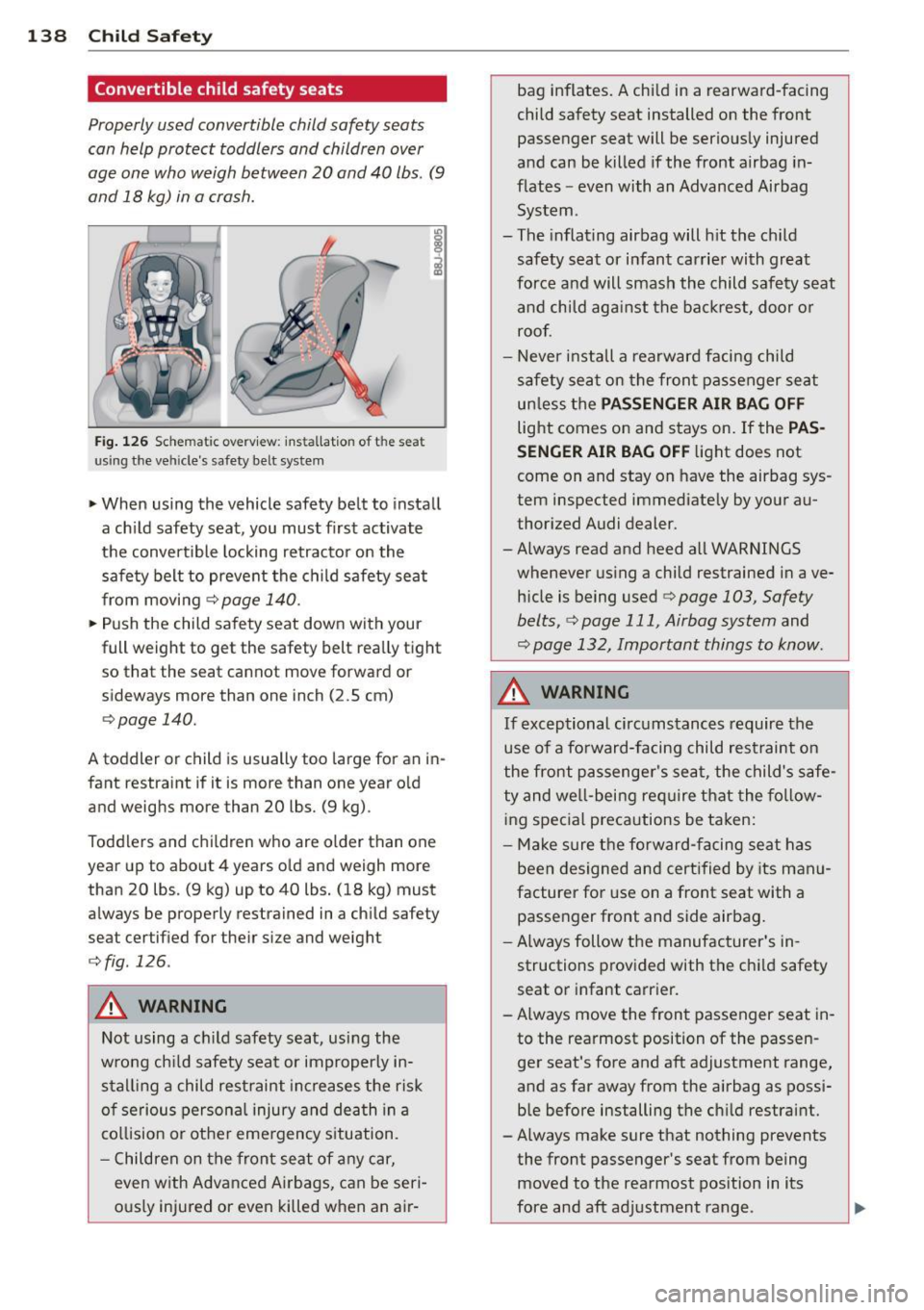
138 Child Safet y
Convertible child safety seats
Properly used convertible child safety seats
can help protect toddlers and children over
age one who weigh between
20 and 40 lbs. (9
and 18 kg) in a crash.
Fig . 126 Schematic overv iew: installat ion of the seat
usin g the vehicle's safety belt system
~ When using the vehicle safety belt to install
a ch ild safety seat, you must first activate
the convertible locking retractor on the safety belt to prevent the c hild safety seat
from movi ng
Q page 140.
~ Push the child safety seat down with your
full weight to get the safety belt rea lly tight
so that the seat cannot move forward or
sideways more than one inch (2.5 cm)
Qpage 140.
A toddler or child is usually too large for an inĀ
fant restraint if it is more than one year old
and weighs more than 20 lbs. (9 kg) .
Toddlers and ch ildren who are o lder than one
year up to about 4 years o ld and weigh more
than 20 lbs . (9 kg) up to 40 lbs. (18 kg) must
always be properly restrained in a child safety
seat certi fied for the ir size and weight
Qfig. 126.
&_ WARNING
Not using a ch ild safety seat, us ing the
w rong ch ild safety seat or improperly inĀ
stal ling a child restraint increases the risk
o f se rious persona l injury and death in a
co llision or othe r eme rgency s ituation.
- Children on t he front seat of a ny car,
even w ith Advanced A irbags, can be seriĀ
ous ly injured or even killed when an air- bag inflates. A chi
ld in a rearward-facing
child safety seat installed on the front
passenger seat will be seriously injured
and can be killed if the front airbag inĀ
flates -even with an Advanced Airbag
System .
- The inflating airbag will h it the ch ild
safety seat or infant carrie r with great
for ce and will smash the child safety seat
and child aga inst the ba ckrest, door or
roof .
- Neve r install a rearward facing child
safety sea t on the fron t passenger seat
un less the
PASSENGER AIR BAG OFF
light comes on and stays on. If the PASĀ
SENGER AIR BAG OF F
light does not
come on and stay on have the airbag sysĀ
tem inspected immediately by your auĀ
thorized Audi dealer.
- Always read and heed all WARNINGS
whenever us ing a child restrained in aveĀ
h icle is being used
Ā¢ page 103, Safety
belts,
Q page 111, Airbag system and
Q page 132, Important things to know .
&_ WARNING
--
If exceptional circumstances require the
use of a fo rward-facing child restraint on
the front passenger 's seat , the child's safeĀ
ty and well-bei ng req uire t hat the fo llowĀ
i ng spec ial precautions be taken:
- Make sure the forward- facing seat has
been designed and cert ified by its man uĀ
facturer for use on a front seat with a
passenger front and side airbag.
- Always follow the manufacturer 's in Ā
structions p rovided with the chi ld safety
seat or infant carrier.
- A lways move the front passenger seat inĀ
to the rearmost position of the passenĀ ger seat's fore and aft adjustment range,
and as far away from the airbag as possiĀ
b le before installing the child restraint.
- Always make sure that nothing prevents
the front passenger 's seat from being
moved to the rearmost position in its
fore and aft adjustment range .